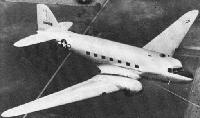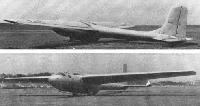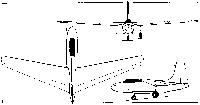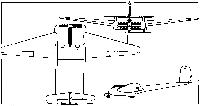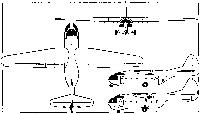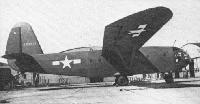Фотографии
-
The Douglas XCG-17 was a standard C-47 transport airframe with all excess weight and unnecessary fittings removed, and was intended for a towing behind a C-54.
Самолёты на фотографии: Douglas DC-3 / C-47 Skytrain/С-53 Skytrooper / Dakota - США - 1935
-
The Waco CG-4A which was built in larger numbers than all other transport gliders combined.
Самолёты на фотографии: WACO CG-4A Hadrian - США - 1942
-
Регистрационный номер: GH-6506 Десантный планер XCG-18A в полете
The first prototype of the XCG-18A Avitruk.Самолёты на фотографии: Chase XCG-18 - США - 1947
-
Регистрационный номер: GJ-787 The last transport glider to be developed in the USA, the Chase XG-20.
Самолёты на фотографии: Chase XCG-20 - США - 1948
-
The second prototype Allied XLRA-1 amphibious glider.
Самолёты на фотографии: Allied XLRA-1 - США - 1943
-
A general arrangement drawing of the XLRQ-1, with the lower side-view illustrating, for comparison purposes, the other USN amphibious glider, the Allied XLRA-1.
Самолёты на фотографии: Allied XLRA-1 - США - 1943Bristol XLRQ-1 - США - 1943
-
The Bowlus XCG-8 which was basically a scaled-up version of the XCG-7.
Самолёты на фотографии: Bowlus XCG-7 / XCG-8 - США - 1941
-
The Bowlus XCG-7 which was built to meet the requirement eventually fulfilled by the Waco XCG-3.
Самолёты на фотографии: Bowlus XCG-7 / XCG-8 - США - 1941
-
The second Bristol XLRQ-1 amphibious glider.
Самолёты на фотографии: Bristol XLRQ-1 - США - 1943
-
The Chase XCG-14 alias MS-1, the first glider to feature the Strukoff aerofoil.
Самолёты на фотографии: Chase XCG-14 / MS-1 - США - 1944
-
Самолёты на фотографии: Cornelius XFG-1 - США - 1943
-
The unique Cornelius XFG-1 expendable fuel transport glider which was automatically stable in both towed and free flight.
Самолёты на фотографии: Cornelius XFG-1 - США - 1943
-
The General Airborne XCG-16 "lifting body" transport glider.
Самолёты на фотографии: General Airborne XCG-16 - США - 1944
-
A general arrangement drawing of the General Airborne XCG-16 "lifting body" transport glider.
Самолёты на фотографии: General Airborne XCG-16 - США - 1944
-
The sole prototype of the St Louis XCG-5 which was unique among transport gliders in featuring a sailplane-style "gull" wing.
Самолёты на фотографии: St Louis XCG-5 - США - 1942
-
The transport glider designed by Ivo Sostaric to meet a Yugoslav Army requirement.
Самолёты на фотографии: Sostaric Glider - Югославия - 1952
-
The second XCG-10A
Самолёты на фотографии: Laister-Kauffman XCG-10 - США - 1944
-
A general arrangement drawing of the Laister-Kauffman XCG-10A with a comparison side-view (lower) of the YCG-10A.
Самолёты на фотографии: Laister-Kauffman XCG-10 - США - 1944
-
Its aerodynamically refined derivative, the Waco CG-15A.
Самолёты на фотографии: WACO CG-15A - США - 1944
-
The Waco CG-13A, the largest transport glider to enter production in the USA, which was built to an AAF requirement for a glider offering twice the capacity of the CG-4A.
Самолёты на фотографии: WACO CG-13A - США - 1943
Статьи
- Airscene
- Fighter A to Z (13)
- In print
- Model enthusiast
- Talkback
- ??? - Arabian Fledgling ... the Royal Saudi Air Force
- ??? - Firefly: A masterpiece for the matelots (2)
- ??? - Lynx: Yeovil's Revolutionary Yearling
- ??? - The Rise and Demise of a Weapon (4)
- E.Brown - Mastering Heinkel's Minimus /Viewed from the Cockpit/
- L.Coombs - Front-office evolution (2)
